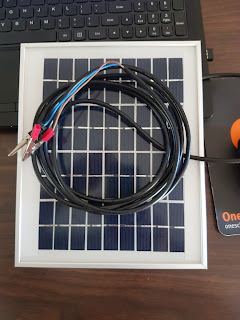After looking around for portable power, there is plenty to choose from, some good, some better and some, well, better off left alone. There's a lot out there if you just want to charge a phone. But when you have LED lights, tablets, a GPS and/or Garmin unit, cameras, along with your phone you need something up to the challenge.
If your travelling around and staying in hostels, motels or pubs, this really isn't an issue as you have the luxury of charging every night from the wall. But...when you want to travel like I do, free camping and self sufficient, portable power becomes like water, a necessity.
I was looking at good brands like Power Monkey, but some of their units are around $300.00 AUD. Yes a great unit, but far outside of the budget of someone who is doing this with tightened purse strings like me. There are a lot of cheaper ones out there online but, you just don't know what you're getting, especially when you have no-one to ask, or reviews written. I've been bitten on line before, and when purchasing what you know, its great, but, well...when its something foreign that's a different story. For me anyway.
After looking at what I had to be charged regularly, I then started to look at the power I needed. I wanted something small and light as well. After looking at options via hiking stores etc, I saw a lot of flexible solar mats. Ones that provided enough supply were reasonable big and need to be folded out. Others that were smaller were great for an item. I also need to be parked up and have these out in the sun when stationary. I wanted something I could charge a battery through the day whilst riding. Again, these options proved outside my budget.
I thought to myself, "There has to be a way I can make one within my budget". After talking to the guys at Jaycar in town, I came up wit the solution.
No, I couldn't get a flexible panel or mat, but I was able to get a 5 watt panel that is small. It measures in at 250 mm x 210 mm x 10 mm and weighs only 690 gm and made by Powertech. I have a folding 120 watt panel by Powertech for my camper trailer and it has never let me down. So it was a brand I knew...that was a start.
Panel = $29.95
Secondly, I needed a battery. I first thought of a rechargeable power pack, the ones that you buy to recharge a mobile phone on the go. But being lithium, I found out these weren't acceptable for my needs. Needed a lead battery, a sealed, non-spillable type.
I went with a Diamec 12 volt 2.2ah/20hr battery. I can charge my phone, lights, camera, all my stuff overnight and have 20 hours of charge running at 2.2 amps.
For thos items such as my Solar Storm lights that do not charge via a USB cable, but rather a charger that plugs into 240 v, the battery is strong enough to run my 200w power inverter...brilliant. It can charge through the day via the solar panel and then in turn charge everything I have at night. The 5 w panel does not need a regulator as the low wattage poses no threat in over charging the battery. The battery is 165 mm x 35 mm x 60 mm and weighs 880 gm. It cost $23.95
Diamec Sealed Lead Battery
12v2.2AH/20HR
200 w Power Inverter
Power light off
Power light on
Powering a 240 v charger
Connected to the battery is a cigarette 12 v outlet along (free, I had an old lead at home with one on) along with a dual 12 v USB outlet ($ ). Its all kept nice and tidy in a small storage box ($2.99).
Inexpensive storage
The panel sitting on top of the box
Battery and connectors stored within the box
The 12 v socket
A double USB socket gives ample charging options
The double USB socket alive and working
All completed it has come in at under $90.00, far less expensive than pre-made and marketed kits. The box is waterproof and is light and compact.
The panel is connected to the battery which is housed in the small storage box. The double 12 v USB point and 12 v connection is connected to the battery and also stores neatly withing the box. The box is secured to the panel by Velcro looping, and Velcro also secures the whole of the unit to the back of the rack, or on top of what ever else is stored on the rack at the time. Throughout the days ride the battery is charged and at the end the panel is removed, box is opened and appliances connected to recharge.
I have also converted a small, old solar panel, around 1.5 watts in output, to mount to my handlebar bag. This will be at the front to help keep the Garmin and phone charged throughout the day if things get a little long, or overused. It was off a cheap solar shed light that I purchased from Bunnings years ago and its cheaper to buy a new one than replace the batteries in it...
It still puts out power, and enough for a phone, or small appliance to charge whilst on the go.















Looks like a good set up. Struggling with this myself at the moment.
ReplyDeleteCheers
Chris
It was simple and cheap...and works ok
Delete